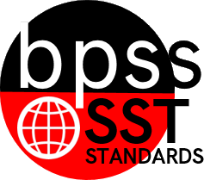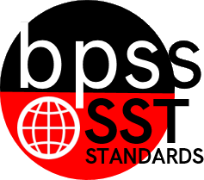SST-07.3
 Standard 3: Standard 3:
Economic Concepts
Students understand economic concepts and the characteristics of various economic systems.
|
Narrative for the Economic Concepts
In the future this will contain narratives and other information about the Standard.
Calculation Method for Standards
Standards are larger groups of related benchmarks. The Standard Grade is a calculation of all the related benchmarks. Click on the benchmark name below each Standard to access the learning targets and proficiency rubrics for each standard's related benchmarks. |
|
SST-07.3.01
|
7th Grade SST Targeted Benchmarks
Standard 3: Economics
SST-07.3.01 Identify how people organize for the production, distribution, and consumption of goods and services (e.g., economic systems; i.e., capitalism, socialism, communism).
|
Student Learning Targets:
Knowledge Targets
- I can describe how a product travels from producer to consumer.
- I can explain why it is necessary to create industry on a large scale.
- I can explain how production was increased due to the Industrial Revolution.
Reasoning Targets
- I can compare and contrast major economic systems.
- I can compare the history, government, and culture of early American civilizations.
Skills (Performance) Targets
- I can evaluate the relationship and conflicts among the North American countries.
- I can summarize how production was increased due to the Industrial Revolution.
Proficiency Scale
| Score |
|
Description |
Sample Activity
|
| 4.0 |
In addition to Score 3.0, the student demonstrates in-depth inferences and applications regarding more complex material that go beyond end of instruction expectations. |
- |
| |
3.5 |
In addition to Score 3.0 performance, the student demonstrates in-depth inferences and applications regarding the more complex content with partial success. |
| 3.0 |
“The Standard.” The student demonstrates no major errors or omissions regarding any of the information and processes that were end of instruction expectations.
The student:
- describes the causes and effects of the Industrial Revolution.
- explains how large scale industry changed Europe and America.
- identifies the pros and cons of the Industrial Revolution.
|
-
When given an event in the Industrial Revolution, determine the effect.
-
Create a chart listing the pros and cons of the Industrial Revolution.
-
Summarize how large scale industry changed Europe and America, specifically relating to urbanization and social issues.
|
| |
2.5 |
The student demonstrates no major errors or omissions regarding the simpler details and processes (Score 2.0 content) and partial knowledge of the more complex ideas and processes (Score 3.0 content). |
| 2.0 |
The student demonstrates no major errors or omissions regarding the simpler details and processes but exhibits major errors or omissions regarding the more complex ideas and processes (Score 3.0 content) as the student:
- recognizes or recalls specific terminology, such as: Industrial Revolution, invention, assembly line, capital, urbanization, etc.
- identify various inventions (e.g. Spinning Jenny, telegraph, telephone, etc.)
- identify various inventors (e.g. Thomas Edison, Albert Einstein, James Watt).
|
-
When given a term, give the definition.
-
When given an invention, explain what it does
-
When given an inventor, describe their contributions to the Industrial Revolution.
|
| |
1.5 |
The student demonstrates partial knowledge of the simpler details and processes (Score 2.0 content) but exhibits major errors or omissions regarding the more complex ideas and procedures (Score 3.0 content). |
| 1.0 |
With help, the student demonstrates a partial understanding of some of the simpler details and processes (Score 2.0 content) and some of the more complex ideas and processes (Score 3.0 content). |
- |
| |
0.5 |
With help, the student demonstrates a partial understanding of some of the simpler details and processes (Score 2.0 content) but not the more complex ideas and processes (Score 3.0 content). |
Resources
Websites
Vocabulary |
|
SST-07.3.02
|
7th Grade SST Targeted Benchmarks
Standard 3: Economics
SST-07.3.02 Differentiate among currency values and their exchange rates.
|
Student Learning Targets:
Knowledge Targets
Reasoning Targets
Skills (Performance) Targets
Product Targets
Proficiency Scale
| Score |
|
Description |
Sample Activity
|
| 4.0 |
In addition to Score 3.0, the student demonstrates in-depth inferences and applications regarding more complex material that go beyond end of instruction expectations. |
- |
| |
3.5 |
In addition to Score 3.0 performance, the student demonstrates in-depth inferences and applications regarding the more complex content with partial success. |
| 3.0 |
“The Standard.” The student demonstrates no major errors or omissions regarding any of the information and processes that were end of instruction expectations. |
- |
| |
2.5 |
The student demonstrates no major errors or omissions regarding the simpler details and processes (Score 2.0 content) and partial knowledge of the more complex ideas and processes (Score 3.0 content). |
| 2.0 |
The student demonstrates no major errors or omissions regarding the simpler details and processes but exhibits major errors or omissions regarding the more complex ideas and processes (Score 3.0 content). |
- |
| |
1.5 |
The student demonstrates partial knowledge of the simpler details and processes (Score 2.0 content) but exhibits major errors or omissions regarding the more complex ideas and procedures (Score 3.0 content). |
| 1.0 |
With help, the student demonstrates a partial understanding of some of the simpler details and processes (Score 2.0 content) and some of the more complex ideas and processes (Score 3.0 content). |
- |
| |
0.5 |
With help, the student demonstrates a partial understanding of some of the simpler details and processes (Score 2.0 content) but not the more complex ideas and processes (Score 3.0 content). |
| 0.0 |
Even with help, the student demonstrates no understanding or skill. |
- |
Resources
Websites
Vocabulary |
|
SST-07.3.03
|
7th Grade SST Targeted Benchmarks
Standard 3: Economics
SST-07.3.03 Identify major historical events and issues (e.g., conflicts and resolutions, natural resources) within regions of the world and their impact world today.
|
Student Learning Targets:
Knowledge Targets
- I can explain how trade goods travel around the world.
- I can define trade partners of the United States.
Reasoning Targets
Skills (Performance) Targets
Product Targets
Proficiency Scale
| Score |
|
Description |
Sample Activity
|
| 4.0 |
In addition to Score 3.0, the student demonstrates in-depth inferences and applications regarding more complex material that go beyond end of instruction expectations. |
- |
| |
3.5 |
In addition to Score 3.0 performance, the student demonstrates in-depth inferences and applications regarding the more complex content with partial success. |
| 3.0 |
“The Standard.” The student demonstrates no major errors or omissions regarding any of the information and processes that were end of instruction expectations. |
- |
| |
2.5 |
The student demonstrates no major errors or omissions regarding the simpler details and processes (Score 2.0 content) and partial knowledge of the more complex ideas and processes (Score 3.0 content). |
| 2.0 |
The student demonstrates no major errors or omissions regarding the simpler details and processes but exhibits major errors or omissions regarding the more complex ideas and processes (Score 3.0 content). |
- |
| |
1.5 |
The student demonstrates partial knowledge of the simpler details and processes (Score 2.0 content) but exhibits major errors or omissions regarding the more complex ideas and procedures (Score 3.0 content). |
| 1.0 |
With help, the student demonstrates a partial understanding of some of the simpler details and processes (Score 2.0 content) and some of the more complex ideas and processes (Score 3.0 content). |
- |
| |
0.5 |
With help, the student demonstrates a partial understanding of some of the simpler details and processes (Score 2.0 content) but not the more complex ideas and processes (Score 3.0 content). |
| 0.0 |
Even with help, the student demonstrates no understanding or skill. |
- |
Resources
Websites
Vocabulary |
|
SST-07.3.04
|
7th Grade SST Targeted Benchmarks
Standard 3: Economics
SST-07.3.04 Identify ways (e.g., GNP, GDP, literacy rate, industrialization) to measure economic progress.
|
Student Learning Targets:
Knowledge Targets
Reasoning Targets
Skills (Performance) Targets
Product Targets
Proficiency Scale
| Score |
|
Description |
Sample Activity
|
| 4.0 |
In addition to Score 3.0, the student demonstrates in-depth inferences and applications regarding more complex material that go beyond end of instruction expectations. |
- |
| |
3.5 |
In addition to Score 3.0 performance, the student demonstrates in-depth inferences and applications regarding the more complex content with partial success. |
| 3.0 |
“The Standard.” The student demonstrates no major errors or omissions regarding any of the information and processes that were end of instruction expectations. |
- |
| |
2.5 |
The student demonstrates no major errors or omissions regarding the simpler details and processes (Score 2.0 content) and partial knowledge of the more complex ideas and processes (Score 3.0 content). |
| 2.0 |
The student demonstrates no major errors or omissions regarding the simpler details and processes but exhibits major errors or omissions regarding the more complex ideas and processes (Score 3.0 content). |
- |
| |
1.5 |
The student demonstrates partial knowledge of the simpler details and processes (Score 2.0 content) but exhibits major errors or omissions regarding the more complex ideas and procedures (Score 3.0 content). |
| 1.0 |
With help, the student demonstrates a partial understanding of some of the simpler details and processes (Score 2.0 content) and some of the more complex ideas and processes (Score 3.0 content). |
- |
| |
0.5 |
With help, the student demonstrates a partial understanding of some of the simpler details and processes (Score 2.0 content) but not the more complex ideas and processes (Score 3.0 content). |
| 0.0 |
Even with help, the student demonstrates no understanding or skill. |
- |
Resources
Websites
Vocabulary |
|
 BPS District Social Studies Standards Book
BPS District Social Studies Standards Book

 Standard 3:
Standard 3: